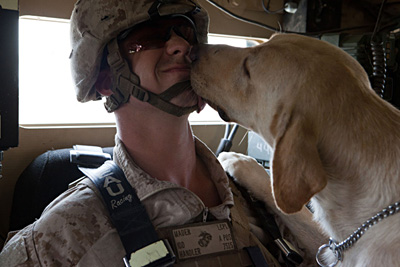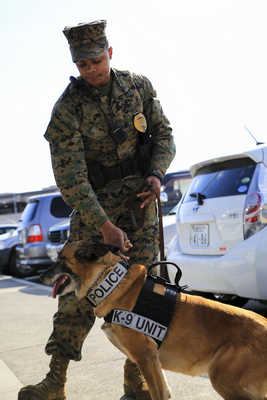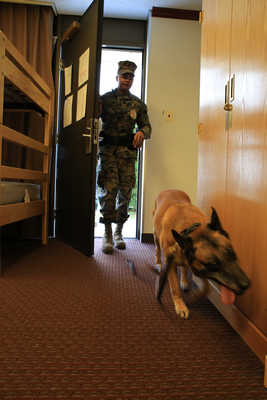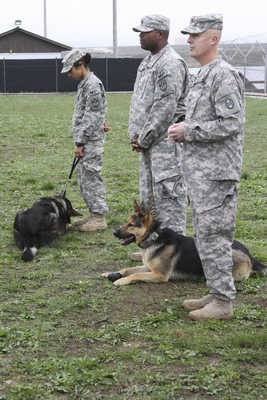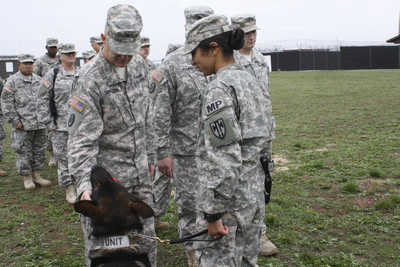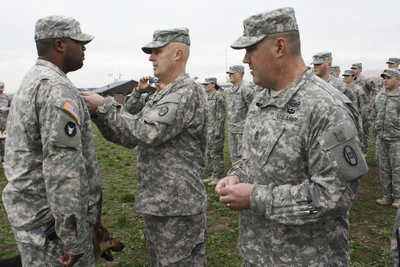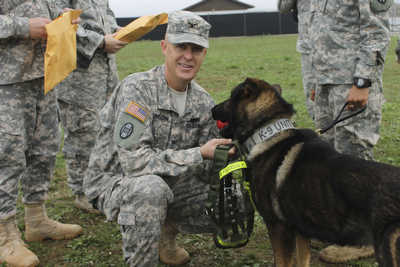Articles and Photos of Interest

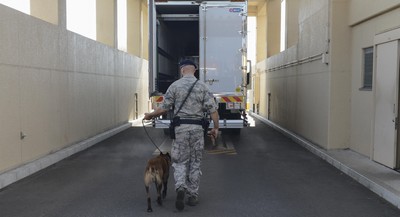
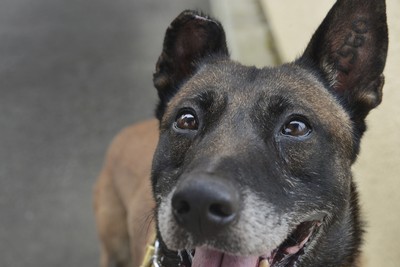
Not your average wingman
8/5/2015 - YOKOTA AIR BASE, Japan (AFNS) -- Every day as the sun rises above the horizon, Yokota Air Base's defenders are already hard at work keeping the base safe. Their day begins when they are assigned a patrol car, protective equipment and their partner. Just like in civilian law enforcement, military patrolmen place their lives in their partner's hands, forging bonds of trust and respect. The 374th Security Forces military working dog handlers take that bond to the next level; the dog isn't just their partner, the dog is family.
Kennel masters across the Air Force diligently study personality profiles of their charges, human and canine, to form the best teams possible. Such is the case with Staff Sgt. Nicholas Galbraith, a 374 SFS MWD handler, and his partner, Topa.
"Dogs, just like people, have their own personalities, and Topa and I have the same kind of mentality," Galbraith said. "He's very high drive. He's the kind of dog that when he needs something he'll go straight for it, and I understand that."
As a Belgian Malinois, Topa doesn't possess the jaw strength of a German shepherd, but makes up for it with his boundless energy and fighting spirit according to Galbraith. Like all Air Force defenders, Topa was trained at Joint Base San Antonio-Lackland, Texas, where that fighting spirit cost him half an ear during rough play with the other MWDs. He began to show signs of a dog-aggressive nature. This worked out perfectly for Galbraith.
"When I went back to Lackland for training, both dogs that were assigned to me showed dog-aggressive tendencies." Galbraith said. "It's almost like I was being trained to work with Topa from the start."
According to Galbraith, the personalities of both the handler and the dog are important when forming teams. A large disconnect between the two can cause a pair of otherwise talented individuals to form a lackluster partnership. Learning how to read the emotions and mindset of the animal is just one way that handlers can work to bridge that gap.
"My boy has a lot of energy," Galbraith said proudly, patting Topa's head. "If he was placed with a more laidback handler he'd either be really bored or walk all over that handler."
High drive and energy isn't solely Topa's domain. Galbraith is a self-proclaimed fitness guru who practices martial arts, including muay thai, as a form of stress relief and to maintain his physical well-being.
"Being physically, mentally, spiritually and socially fit is just as important for the dog," Galbraith said. "The whole Airman concept applies to them too because they have to deal with the same stressors we do and sometimes more."
To be prepared for working with his four-legged wingman, Galbraith was given emergency field veterinary care similar to the self-aid and buddy care taught to Airmen in basic military training. This is just one more way in which MWDs are comparable to their human counterparts. Despite all of these similarities, handlers must always remember their partner isn't human.
"Sometimes it's easy to forget that they really are just dogs and still do dog things like sniffing and marking territory," Galbraith said. "It's their pack mentality which makes the MWDs loyal to their handler before anyone else."
Topa is Galbraith's first canine partner outside of training, and they have been working together for one year. Handlers in the Air Force are assigned a different MWD at each base they are assigned to, in contrast to the other branches of service where a team is only broken when one of the members separates from the military.
"Yokota is my first base as a K-9 handler, and Topa's the first K-9 I've worked with," Galbraith said. "I got lucky with him, he's an awesome dog. I'm sure everyone says that about their dog but I truly believe I couldn't have gotten a better partner."
Read Original Article
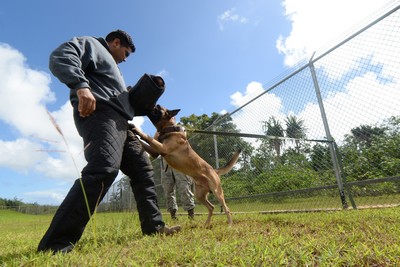
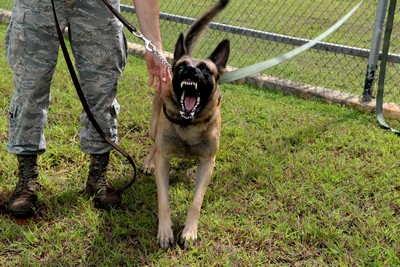
Airmen work hand-in-paw with four-legged wingmen
11/5/2015 - ANDERSEN AIR FORCE BASE, Guam (AFNS) -- The bond between man and dog is a special one, dating back to times when wolves and men would hunt together. Through years of evolution and change, the relationship between dogs and humans has grown stronger.
Despite evolving technology of surveillances and detection, the skill of a trained working dog and his or her handler remains unrivalled when it comes to ensuring the safety and security of the bases and resources around the world. The relationship and the trust between the pair are what make the mission work.
Opportunities to join these elite crews are limited. The Andersen Air Force Base teams train on a daily basis to keep their skills up-to-date, minds sharp, and bonds strong.
"The work to become a military working dog handler is intense," said Tech. Sgt. Jeremy Toliver, the 36th Security Forces Squadron kennel master.
On top of two years of security forces service and meeting certain job training requirements, Airmen must also submit an application package, he said. Only after being accepted, can they attend the dog handler training.
One of Andersen AFB's most established teams consists of Staff Sgt. Eric Serviss, a 36th SFS dog handler, and his K-9 partner Johny, who have worked together for almost two years. Despite their experience together, they are considered to be a green team, since both dog and handler had little to no experience with the K-9 program before their assignment.
"Johny is Serviss' first dog, and Serviss is Johny's first handler," Toliver explained. "Those two clicked immediately after being partnered together. They work great together and trust each other."
Johny is a German shepherd, one of three breeds typically used in Defense Department police work. The other two include the Belgian Malinois and Dutch shepherd.
"Johny motivates me, works hard and has helped me mature as a dog handler," Serviss said.
Picking Johny was a great learning experience for the team because they got to learn how to work together and become efficient in their job, he said.
Before he teamed up with Johny, the Airman cared for the dogs of other handlers and ensured they exercised and received attention when their handlers were away or off duty.
There are three main jobs a MWD can do: patrol, bomb and narcotics detection. Day-to-day training involves honing these skills and building rapport between handler and dog.
The Andersen AFB kennels are one of the largest out of more than 70 facilities across the Air Force.
While the dogs may remind many of the homebound pets of base housing, these trained workers are a force to be reckoned with at all times.
"I think people just need to be aware that these dogs are not pets," said Staff Sgt. Adrian Chavez, a 36th SFS dog handler trainer. "We love them like pets, but they are our partners. You could look at it like a regular security forces team ... You aren't going to walk up and just pet some guy's partner."
Read Original Article

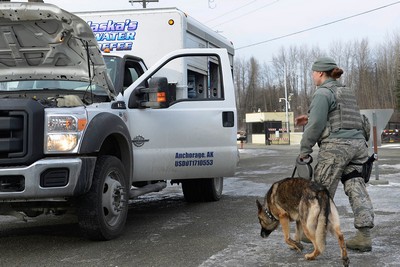

'Covered in fur': MWD handler wouldn't have it any other way
3/17/2016 - JOINT BASE ELMENDORF-RICHARDSON, Alaska -- In the early days of America, women disguised themselves to serve alongside men and be a part of the war effort.
During World War I, women gained their first opportunity to join the U.S. armed forces when the number of wounded American fighters grew and the military realized it was beneficial to enlist women as nurses.
Today, women across the military and the Department of Defense can be found serving in almost any role.
For more than 20 years, March has been proclaimed Women's History Month to honor the countless women who sacrificed and strived to ensure all people have an equal shot at pursuing their dream.
One such woman is Air Force Staff Sgt. Kelly Szydlo, who has been a military working dog handler for more than six years. Currently, she is assigned to the 673d Security Forces Squadron.
Szydlo explained her inspiration to join the Air Force was sparked when her brother joined.
Her first choice was security forces, and she said she was ecstatic when she got it.
After her first deployment, she decided she would go a step further and become a military working dog handler.
Handlers work with their canines to train and detect explosives, find drugs, or provide real deterrents to any person who might have malicious intent.
Working in pairs, military working dogs and handlers share a bond by depending on each other to accomplish their mission.
"I love what I do," Szydlo said. "I would do it forever if they would let me, but it's a very taxing career field. A lot of the handlers find it physically challenging to work with the dogs; it's a lot of wear and tear on the body at times."
Szydlo is currently in the process of retiring her dog Aashley, an 11-year-old black Labrador retriever, while also training a new dog.
"It's a long day," Szydlo said. "I have to keep an eye on both of them, and I'm also learning a new dog from scratch."
In addition to training or patrolling throughout the day, handlers are responsible for bathing the dogs and cleaning the kennels on a regular basis.
"This is not your normal nine-to-five work schedule. Once my 'duty' day is done, there are things around the kennels that I personally like to accomplish." Szydlo said. "I can find myself away from home for extended periods of time, beginning when I hit my alarm to wake up, until the time my boots come off at night."
Szydlo has worked with few other female handlers throughout her career, she said. One of them is Senior Airman Amanda Taylor, Szydlo's own troop.
"This was the first job I wanted in the Air Force, and I had to work to get it," Taylor said. "Security Forces in itself is a heavily male-dominated career field. Being a woman in this career field, it's not a question of the job being easy or hard; you just have to work as hard as everyone else."
"We work with almost all men, but it's no different," Szydlo said. "We're all treated the same way."
The same standards and amount of work are expected of all the handlers, Szydlo said. No matter how long the day might be, everyone is responsible for getting the mission done.
"It's a whole lifestyle and you have to be committed," Szydlo said. "This is my entire life, and I love it."
Read More...

Remembering War Dogs
12/4/2015 - Cpl. Francis Mulcare, military working dog handler, 1st Law Enforcement Battalion, Camp Pendleton, orders his military working dog to engage a simulated enemy combatant during a demonstration at March Field Air Museum on Feb. 21, 2015. The 15th Annual War Dog Remembrance Day honors the sacrifices military working dogs and their handles made during battle while also illustrating the strong bond forged between the two.
Read More...

Senior Airman Casey Wheatley, 36th Security Forces Squadron dog handler, bathes his military working dog Ramos after a grueling day of training Oct. 28, 2015, at Andersen Air Force Base, Guam. On top of training, handlers must also take care of their dogs in other aspects including bathing and veterinary appointments.


Airmen work hand-in-paw with four-legged wingmen
November 05, 2015 - ANDERSEN AIR FORCE BASE, Guam (AFNS) - Opportunities to join these elite crews are limited. The Andersen Air Force Base teams train on a daily basis to keep their skills up-to-date, minds sharp, and bonds strong.
"The work to become a military working dog handler is intense," said Tech. Sgt. Jeremy Toliver, the 36th Security Forces Squadron kennel master.
On top of two years of security forces service and meeting certain job training requirements, Airmen must also submit an application package, he said. Only after being accepted, can they attend the dog handler training.
One of Andersen AFB's most established teams consists of Staff Sgt. Eric Serviss, a 36th SFS dog handler, and his K-9 partner Johny, who have worked together for almost two years. Despite their experience together, they are considered to be a green team, since both dog and handler had little to no experience with the K-9 program before their assignment.
Read More...
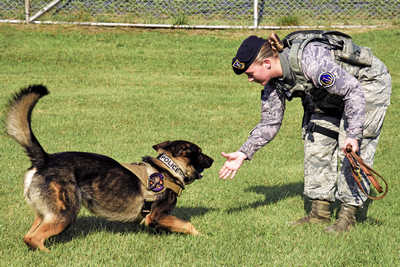

Face of Defense: Airman Takes Path to K-9 Handler Career
10/10/2015 - MISAWA AIR BASE, Japan — Face-to-face with Elvis, an energetic German shepherd dog, U.S. Air Force Senior Airman Alyssa Stamps, a military working dog handler with the 35th Security Forces Squadron, makes a grab for the ball.
Now holding the cherished reward, Stamps chucks the ball across the yard and the dog stampedes after it. However, instead of returning to her with an accomplished strut, he sits with his back to her in the corner of the yard and refuses to cooperate.
Stamps describes this as “battling a streak of stubbornness.” She and Elvis are still in the two-week rapport stage destined to nurture their new relationship. Although frustrating, these visits are just the beginning of her dream becoming a reality.
From living beside dogs as a child to joining the Air Force as a security forces airman, Stamps has knowingly and unknowingly prepared for the duty of a military working dog handler.
Read More...
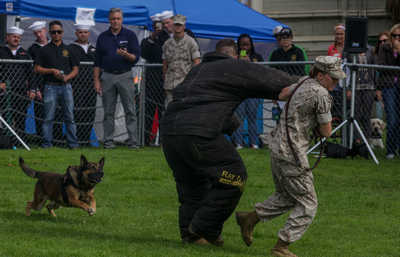
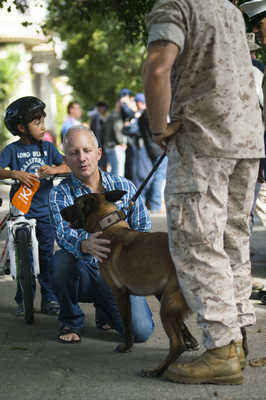
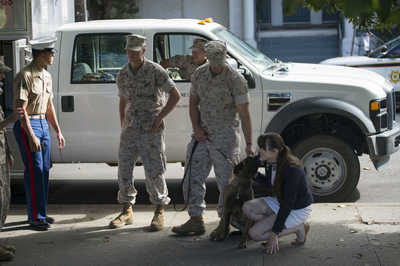

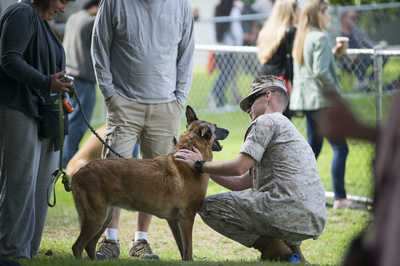
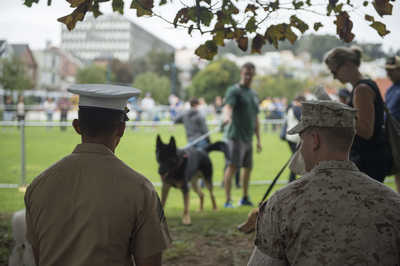
Man’s best friend demonstrates intelligence during San Francisco Fleet Week
10/10/2015 - SAN FRANCISCO - A Marine sprinted towards the other end of the enclosure as Denny, the Belgian Malinois military police dog, quickly traversed the distance in between him and his target. Just as Denny prepared to launch and take down the Marine, his handler screamed “Halt, Sit!” The crowd applauded as the Belgian Malinois stopped on a dime at its handlers command during the Bark at the Park event Oct. 10, as part of San Francisco Fleet Week 2015.
Bark in the Park was conducted as an opportunity for service members, San Francisco government agencies and the citizens of San Francisco to display the different capabilities that can be provided by military working dogs.
Oz Robinson, an apprentice instructor with Canine Companions, said the intelligence displayed by the dogs and the tasks they could accomplish after a little bit of training was unbelievable.
“Dogs are very, very intelligent creatures capable of accomplishing almost anything as long as people take the time to train them and take care of them,” Robinson said. “With a little bit of training these dogs have been able to accomplish wondrous tasks that really aid everyone from service members to people who suffer from disabilities.”
Read More...
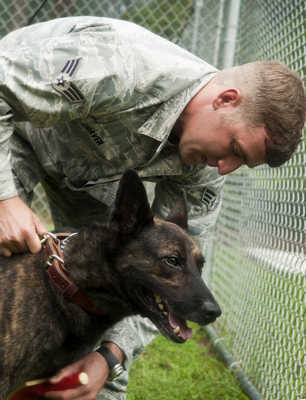
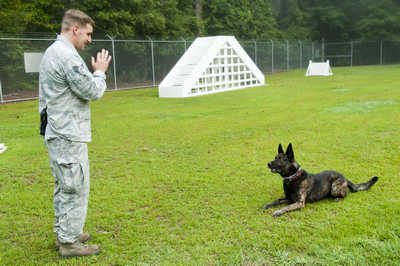


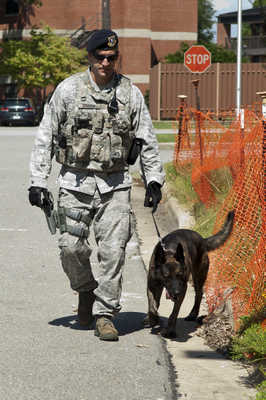

4th SFS’ newest team protect, defend base
9/21/2015 - For Senior Airman Austin Craven, the day begins with the sound of barking and wagging tails before the sun even rises.
“Hey buddy! How you been boy?” Craven says in a high-pitched voice.
As he slides a collar on his four-legged wingman, Craven heads for the exit, followed closely by the source of the barking sounds and tail wagging. After a quick stint of exercise, Craven grabs his gear, complete with tactical vest, Kevlar and radio, as well as a bowl and chew toy. Next, it’s on to the patrol car.
This will be the routine for Craven, a 4th Security Forces Squadron military working dog handler, and his partner in crime, MWD Ronni, for the foreseeable future as they build a bond of friendship and a partnership of trust, working side by side to protect the members of Team Seymour.
Read More...
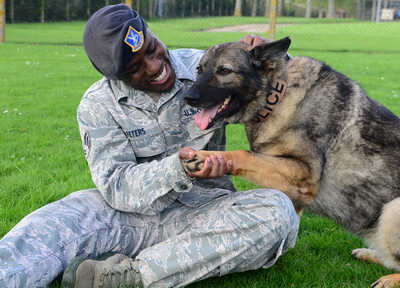
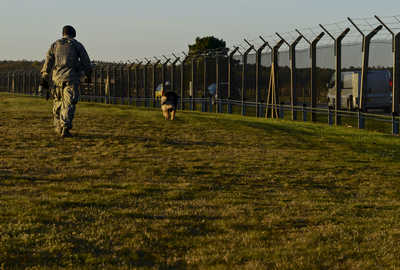
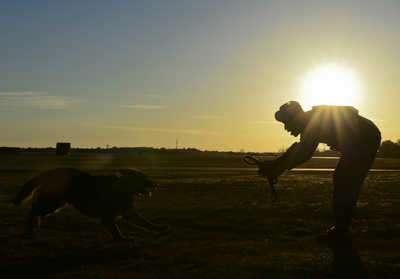


Working dog still fit to fight
9/3/2015 - ROYAL AIR FORCE LAKENHEATH, England - After six years of service, Gina, a 48th Security Forces Squadron military working dog, and her handler of two years, Staff Sgt. Anthony Peters, went to Germany for a full medical review where it would be determined if her 42 years of service, in dog years, would come to an end.
Gina has served on multiple temporary duty assignments throughout Europe, serving on details to protect the president and his family, as well as various political dignitaries. It came as no surprise that after years of wear and tear, Gina would be reviewed and that the possibility of retirement could be in her future.
Read More...
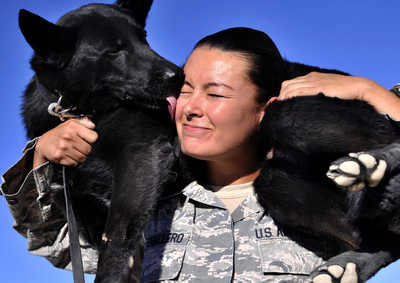
Military Working Dog Kiara licks her handler Staff Sgt. Rosanne Caballero, 799th Security Forces Squadron MWD trainer, after searching vehicles for contraband July 23, 2014, at Creech Air Force Base, Nev. Handlers play with their dogs throughout the day to praise them for a job well done as well as to build a bond between each other.

U.S. Navy Petty Officer 3rd Class Vince Nicholford takes a moment to let Bery, his military working dog, rest on his shoulders on Camp Lemonnier, Djibouti, Dec. 5, 2014. Nicholford, a master-at-arms, and Bery are assigned to security forces on Camp Lemonnier.
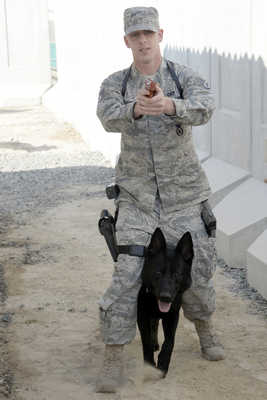
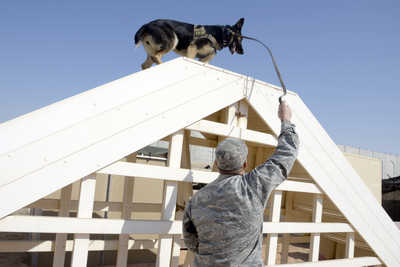
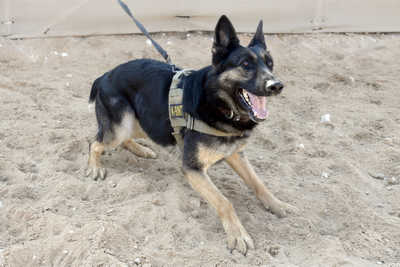

K-9’s lead the way
"He is your friend, your partner, your defender, your dog. You are his life, his love, his leader. He will be yours, faithful and true, to the last beat of his heart. You owe it to him to be worthy of such devotion." - Unknown
Airmen assigned as military working dog handlers can definitely relate to the devotion a K-9 has towards his handler.
“The bond between a MWD and their handler is very hard to break,” said Staff Sgt. Justin. “I rely on just as much as she relies on me. I devote most, if not all of my time to ensure she is at 100 percent.”
The mission of the security forces MWD section is to protect, defend and deter any hostile threats by explosive detection and mitigation by using the MWD.
Read More...
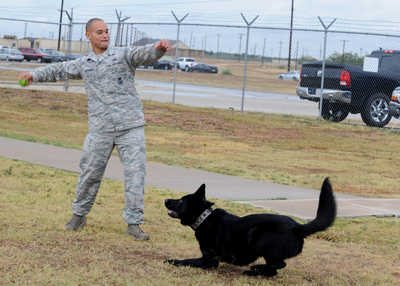
Face of Defense: Airman, Working Dog Form Dynamic Duo
DYESS AIR FORCE BASE, Texas, Dec. 17, 2014 - The shop is full of constant howling, with bones and bouncy balls scattered on the floor and a pungent smell throughout.
Ivan, a black, thick-haired German shepherd military working dog, lies on a couch and greets visitors with a slobbery lick.
It's just another day for Ivan and Air Force Staff Sgt. Andre Hernandez, a 7th Security Forces Squadron military working dog handler.
Read More...


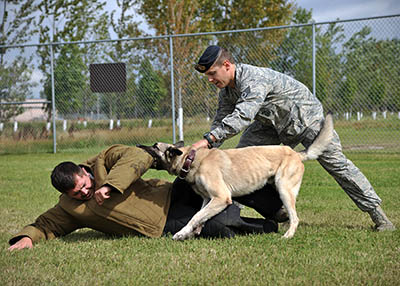

Piece of the Fight: Defenders let the K9s do the Talking
9/17/2014 - GRAND FORKS AIR FORCE BASE,N.D. -- It's "ruff" defending the main gate; weather conditions aren't always great, shift hours are long and guards are up at all times.
However, the main gate is the first line of defense, and if you're an intruder trying to infiltrate the installation, you're barking up the wrong tree.
The unofficial motto of the 319th Security Forces Squadron K9 section is "K9 leads the way." It's their job to detect personnel, drugs or explosives before people or vehicles enter the base. The 341st Training Squadron at Joint Base San Antonio, Texas, is in charge of the entire Department of Defense military working dog program. The "puppy program" looks for a specific breed of dog with qualities such as high drive, prey drive, confidence and dogs that are not sensitive to loud noises.
Read More...

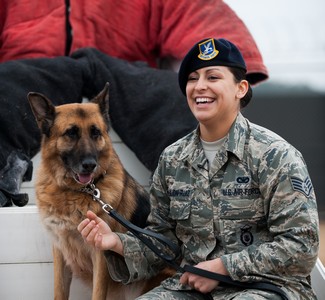


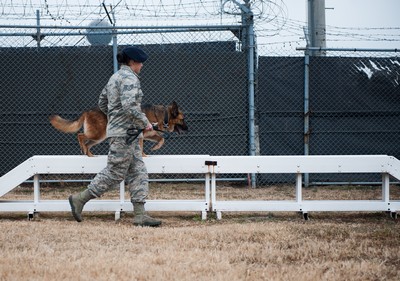
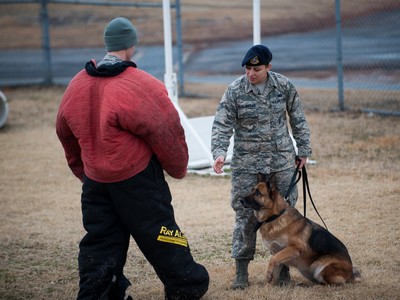
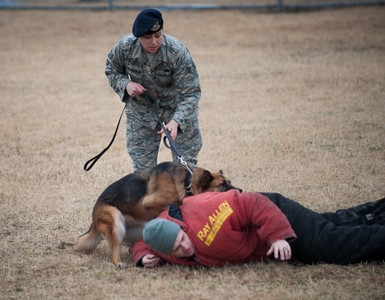


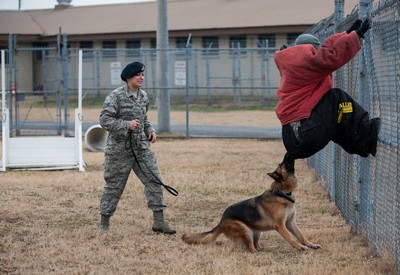

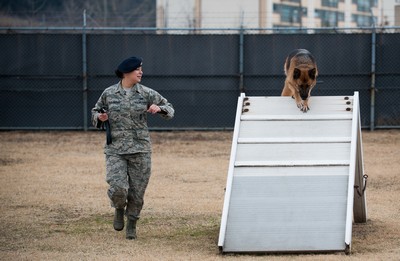
Stella, Bizallion: Guarding the Wolf Pack
3/20/2014 - KUNSAN AIR BASE, Republic of Korea -- Staff Sgt. Monica Bizallion, 8th Security Forces Squadron military working dog handler, trains and works with Stella, 8th SFS military working dog, Mar. 13, 2014. Bizallion and Stella defend the base by detecting, deterring and neutralizing the threats that may appear. As security forces personnel, Bizallion and Stella are charged to protect the people, property and resources of the U.S. Air Force.
Read More...


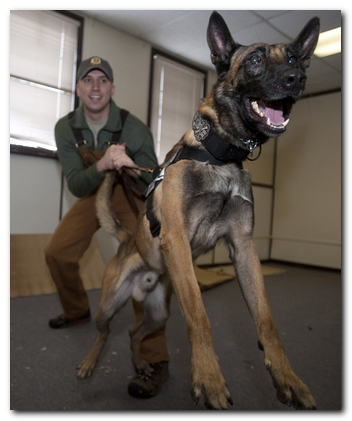
Alaska cold doesn't stop military working dogs
1/29/2014 - JOINT BASE ELMENDROF-RICHARDSON, Alaska -- Four paws sank into snow deep enough to bury the boots of the 673d Security Forces Squadron Military Working Dog handler as the pair made their way through the crystallized water to a training facility on Joint Base Elmendorf-Richardson, Alaska, Jan. 23, 2014.
Even in the winter conditions the northern-most state experiences, personnel maintain installation security. But a vital part of the mission is ensuring the canine personnel stay safe and healthy while performing in the often-extreme climates.
"In the winter, we keep the dogs just warm enough that they are comfortable, but not so warm that they don't want to work outside," said Staff Sgt. Nicholas Woolridge, 673d SFS MWD trainer. "When it's cold enough, we have shorter work cycles. Depending on the temperature, we'll work the dogs for 10 to 15 minutes, let them warm back up, and then take them right back out."
When the dogs need to warm up, the MWD handlers have a trailer with climate controlled kennels. Stepping from a warm kennel onto icy ground sometimes still requires extra protection from the elements.
"Touching the ice gets really cold on the dog's feet," Woolridge said. "When you put your hands on the ice, it's going to burn after a while; it's the same for the dog. Their pads are just as sensitive as our hands. Your dog can suffer from a cold weather injury.
Their feet can get too cold, can crack or get cut open on the ice."
Read More...
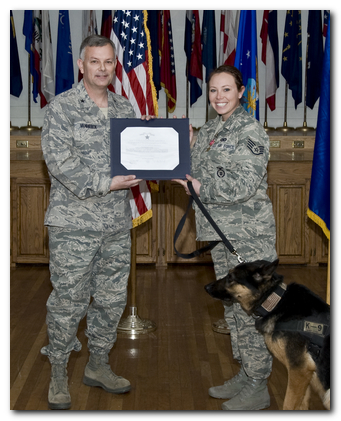
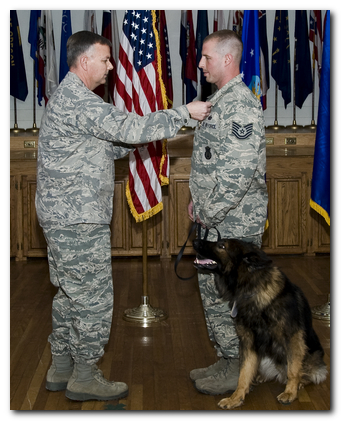
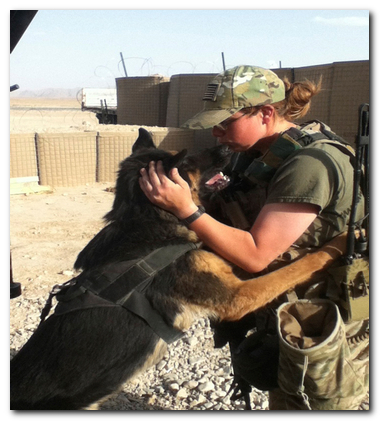
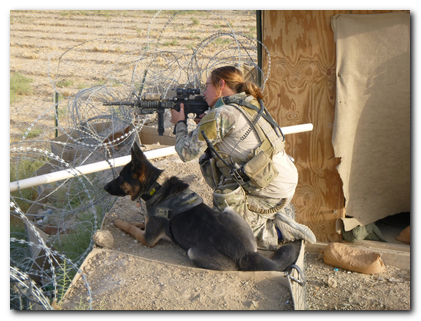

Dyess K-9 trainers receive Bronze Star and Purple Heart Medals
1/31/2014 - DYESS AIR FORCE BASE, Texas -- Two 7th Bomb Wing Security Forces Airmen received two of the highest military awards available during a ceremony Jan. 24, here.
"These two defenders are heroes and warriors," said Brig. Gen. Glen VanHerck, 7th BW commander. "They selflessly go down range to save lives without hesitation."
Staff Sgt. Erica McRell, 7th SFS, was awarded the Bronze Star Medal for her acts of heroism, merit and meritorious service exhibited while in a combat zone.
Read More...

MWD: From BMT to retirement
12/17/2013 - HURLBURT FIELD, Fla. -- Military working dogs are part of everyday operations at the 1st Special Operations Security Forces Squadron here.
MWDs begin their careers like any other Airman at Lackland Air Force Base, Texas, according to Staff Sgt. Ryan Troester, 1st SOSFS kennel master.
"Their initial training usually takes about six months," said Troester. "Initial training to meet basic qualifications when they reach home station is about 60 days, and beyond that we're advancing their training daily."
Once an MWD finishes initial training, they serve the military for the next six to 10 years performing duties such as patrols, narcotic and explosive searches, suspect apprehension, and deployments.
Read More...
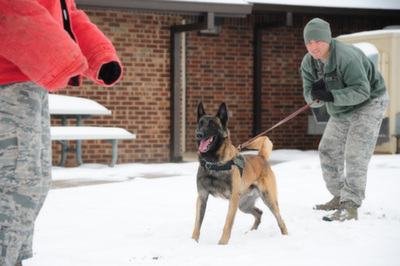
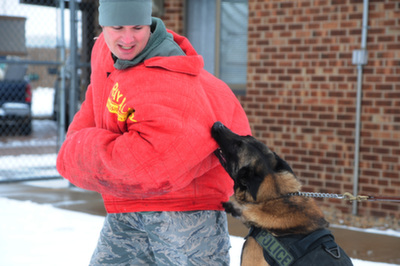


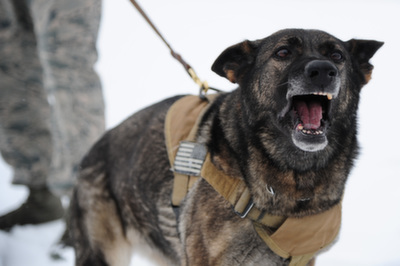
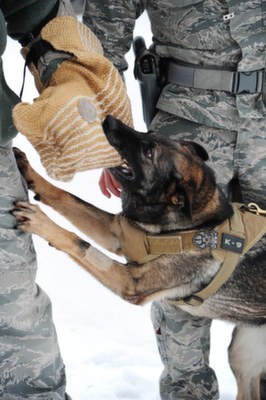
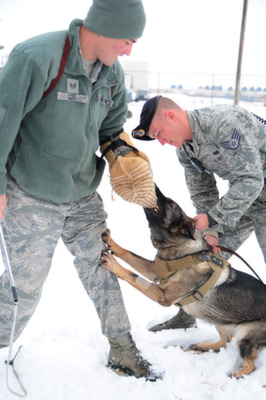
Canines bite into work
11/26/2013 - Zeus, 97th Security Forces Squadron military working dog and U.S. Air Force Staff Sgt. Wesley Cox during training Nov. 25, 2013.
Becky, 97th Security Forces Squadron military working dog, with her handler, U.S. Air Force Staff Sgt. David Smith during training, Nov. 25, 2013
Read More...
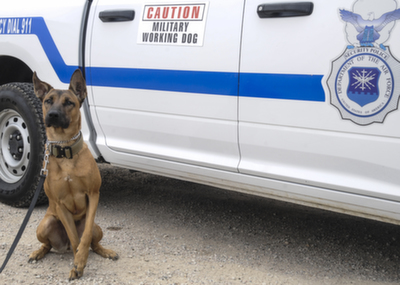
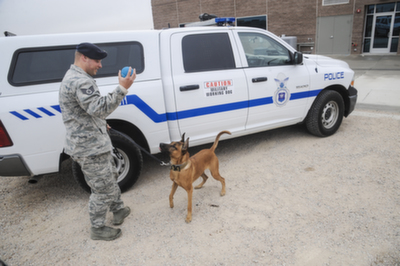
From Germany to Buckley, new dog on the block adjusting well
11/4/2013 - BUCKLEY AIR FORCE BASE, Colo. -- Jeja, a 2-year-old Belgian Malinois hailing from Germany, is the newest addition to the 460th Security Forces Squadron military
working dog kennels.
Before joining the rest of her fellow service dogs, Jeja completed a roughly 90-day training program instructed by members of the 341st Training Squadron, Joint Base San
Antonio-Lackland, Texas.
According to the 341st TS website, they train dogs used in patrol, drug and explosive detection, and specialized mission functions for the Department of Defense and other
government agencies.
After arriving at Buckley, it's now up to Jeja's partner, Staff Sgt. Robert Aikins, 460th SFS MWD handler, to advance her training and become certified as an operational team.
This process generally takes about 60 days, and they must become certified on a number of tasks.
Read More...
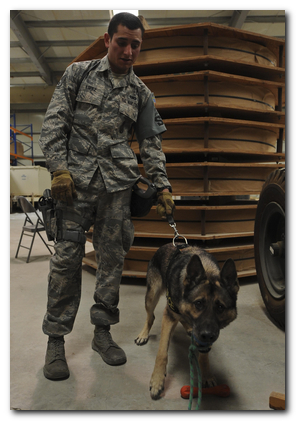

Working dogs, handlers dynamic duo for base defense
8/26/13 - SOUTHWEST ASIA (AFNS) -- Deploying in pairs, military working dogs and their handlers share a bond exclusive to their career field; each directly dependent upon each other to accomplish the mission. This bond is strengthened in a deployed environment keeping the 380th Expeditionary Security Forces Squadron military working dog teams focused on improving their capability. A capability that provides an extra level of protection for the members of the 380th Air Expeditionary Wing and every person visiting the installation.
"In a new environment, a handler and his dog learn more about each other's strengths and weaknesses," said Staff Sgt. Joseph Serrano, 380th ESFS military working dog handler. "A dog can see, hear, and smell things that humans cannot, making them an important member of the security forces team. While deployed, we face new challenges making both of us better. "
MWDs can be trained to smell anything from money to narcotics, to recognize hostile actions and to act appropriately in these situations. Intense heat, long days and new surroundings test these abilities unlike back at home station, said Serrano.
Read More...
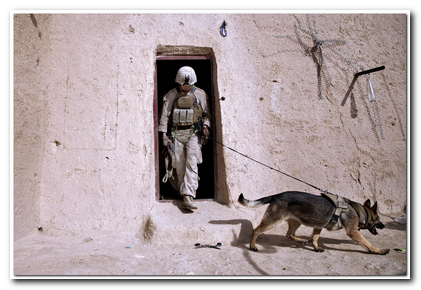
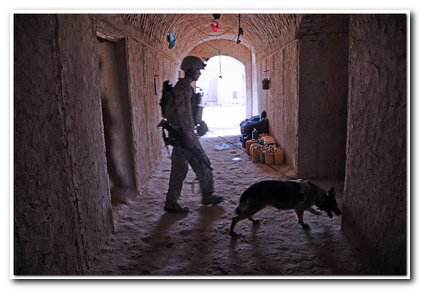
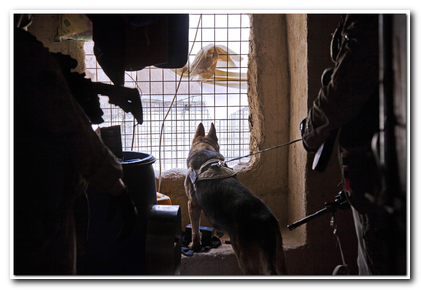
U.S. Marine Corps Lance Cpl. Joseph Nunez and Viky, a military working dog trained to detect improvised explosive devices, search a compound for weapons during Operation Grizzly in Helmand province, Afghanistan, July 18, 2013. Nunez is assigned to Fox Company, 2nd Battalion, 2nd Marine Regiment.
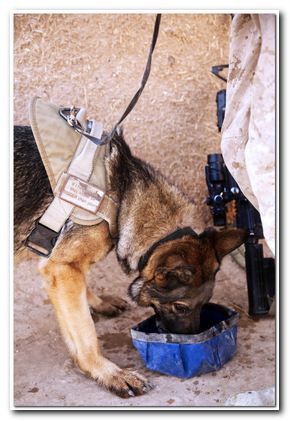
Viky, a U.S. Marine Corps military working dog trained to detect improvised explosive devices, drinks water after searching a compound for weapons during Operation Grizzly in Helmand province, Afghanistan, July 18, 2013.



K-9 Airmen deploy with 'best friend'
7/8/2013 - SOUTHWEST ASIA (AFNS) -- One of the most difficult parts of a deployment for service members is leaving behind friends and family. Security forces Airmen in the Military Working Dog section, however, have a unique opportunity when they deploy.
"We get to deploy with our best friend," said Senior Airman Andrew Hanus, a 379th Expeditionary Security Forces MWD handler, deployed with his K-9 companion, Beni, from Travis Air Force Base, Calif.
They are one of 13 MWD teams here who support the 379th ESFS mission to maintain security and vigilance throughout the wing and ensure no threats enter the base by searching each vehicle prior to entry. The MWDs also serve as a psychological deterrent and are trained to attack perpetrators on command.
Read More...
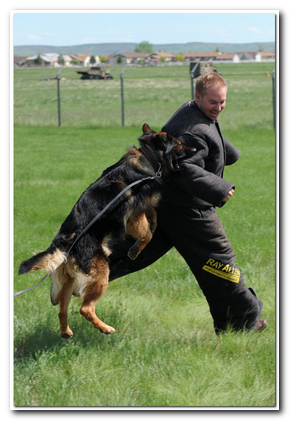
Area leaders experience security forces capabilities
6/12/2013 - ELLSWORTH AIR FORCE BASE, S.D. -- Defenders from the 28th Security Forces Squadron provided 19 civic leaders with the opportunity to see how they get things done during an honorary commander tour event June 7.
During the day, the guests - members of the 28th Bomb Wing Honorary Commanders program -experienced the new active shooter training course in the 28th SFS shoot house, among other 28th SFS activities.
The tour was designed to provide honorary commanders and their spouses with a broader understanding of the mission of the 28th SFS - named the 2012 best medium-sized security forces unit in the Air Force - through a combination of a tour of key facilities, an explanation of the squadron's operations, and an engaging, hands-on learning activity in the new shoot house.
Read More...
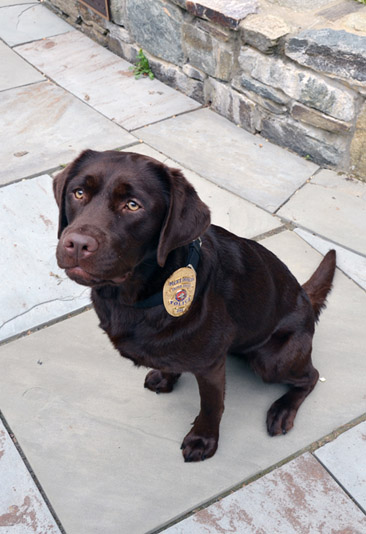
Agency K-9 Unit Places First in Competition
Have you ever noticed how much dogs like to sniff and smell things? That’s because they have very sensitive noses. In fact, dogs can sniff out 19,000 explosive scents, which is an important job the dogs in CIA’s K-9 unit do daily to keep Agency officers safe.
Recently, CIA K-9 teams placed eight of the top 10 finalists at the United States Police Canine Association’s Certification and Trail in Gaithersburg, MD. A CIA Security Protective Officer (SPO) and his K-9, Coca, placed first
Read More...

Through Airmen's Eyes: Dog Handler brings her values to career
6/1/2013 - FORWARD OPERATING BASE PASAB, Afghanistan (AFNS) --It's 6 p.m., and Chrach, a military working dog whose name is pronounced "Crash," is anticipating his evening meal.
His handler has been feeding him twice daily for more than a year, since the two became a team, and she is used to this routine -- but not because she is his handler.
Staff Sgt. Jessie Johnson, a military working dog handler assigned here with the Army's 3rd Infantry Division canine unit, said she was born into an "animal house" and had all of the responsibilities of training the animals, playing with them, taking them to the vet and feeding them.
Read More...

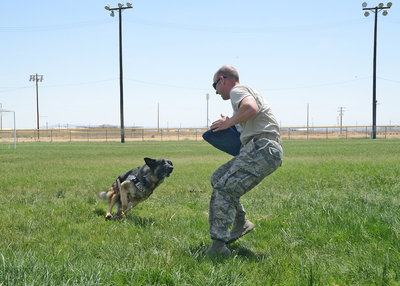
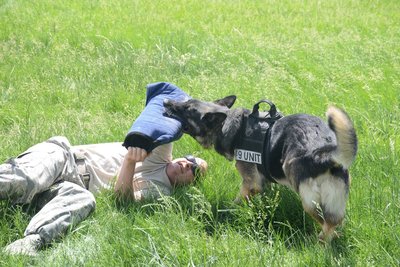
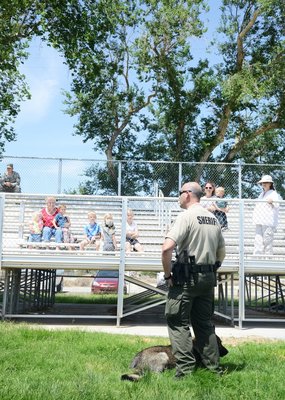
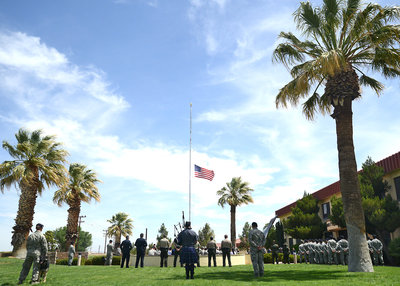
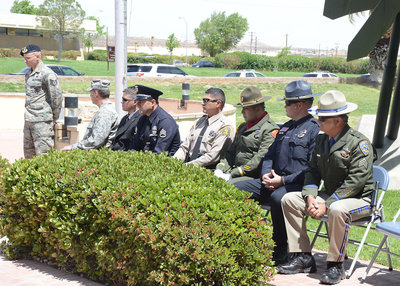
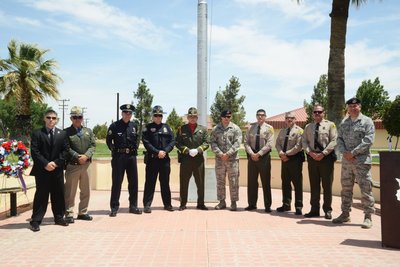
412th SFS, local law enforcement observe National Police Week
5/22/2013 - EDWARDS AIR FORCE BASE, Calif. -- National Police Week was observed May 13 to 17, and here at Edwards, the 412th Security Forces Squadron sponsored several events including a K-9 Working Dog demonstration, a children's drug awareness and security briefing, a multi-agency End of Watch ceremony and a National Memorial Fund Golf Tournament on Friday.
Members of the Kern County Sheriff's Department's K-9 unit joined the 412th SFS May 15 at Arnold Field for a joint K-9 unit and Military Working Dog demonstration.
On May 16, several law enforcement agencies from the surrounding communities converged in front of Building 1 for an End of Watch ceremony to honor fallen police officers and U.S. Air Force security forces personnel. Law enforcement agencies who participated in the ceremony included the Los Angeles County Sheriff's Department, Los Angeles Police Department, Kern County Sheriff's Dept., California Highway Patrol, California City Police Dept., Arcadia Police Dept., Air Force Office of Special Investigations and the U.S. Marshals Service.
Read More...
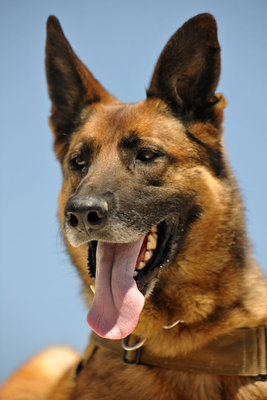
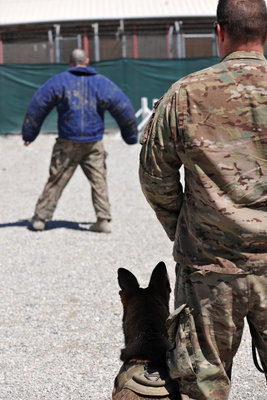
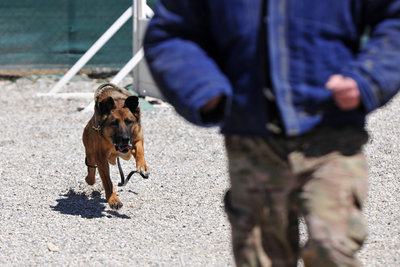
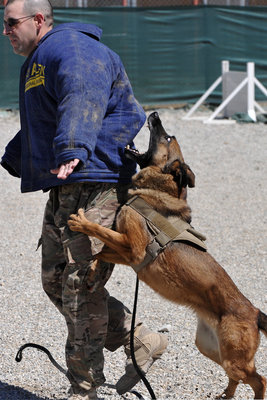
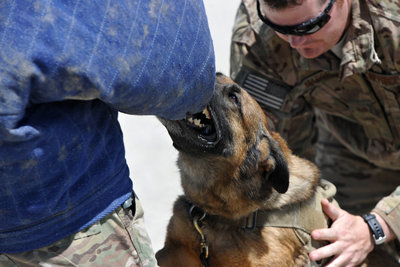
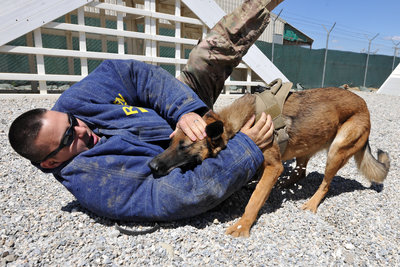
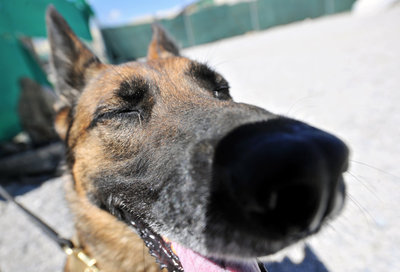

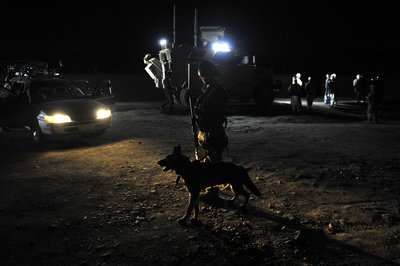
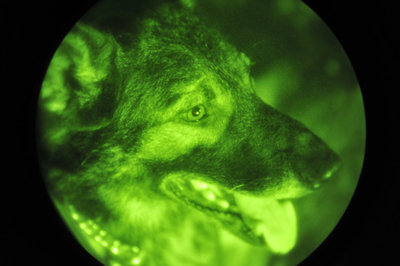

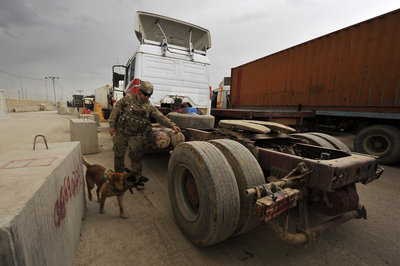
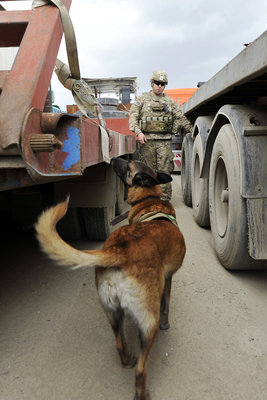
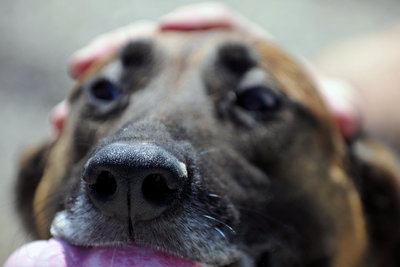
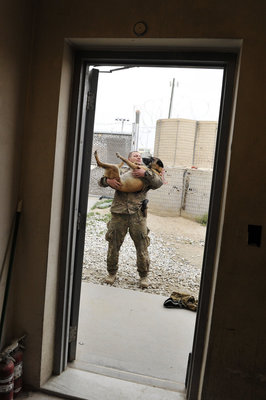
From the leash down
5/5/2013 - BAGRAM AIRFIELD, Afghanistan -- Military Working Dogs and their handlers assigned to the 455th Expeditionary Security Forces Group patrol and protect Bagram Airfield, Afghanistan, and the surrounding area.
The handlers perform weekly controlled aggression training with their dogs and practice in a MWD obstacle course to provide realistic scenarios the team can expect to encounter while on patrol.
Over the past four months, the MWD team has swept more than 15,000 vehicles, mitigating all Vehicle-Borne Improvised Explosive Device threats to the installation and completed more than 200 missions "outside the wire" securing villages and roads leading to the airfield.
Read More and View the Video...


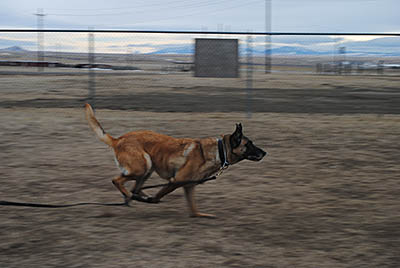
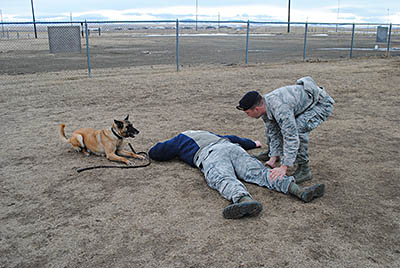

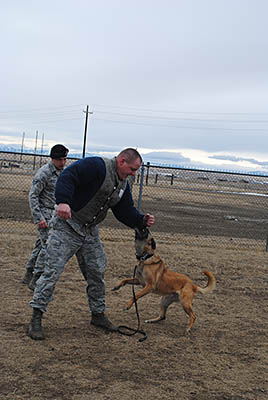
A man's best friend, Wingman
2/7/2013 - MALMSTROM AIR FORCE BASE, Mont. -- Muffled sounds of awe ripple through a crowd on the flighline during a tour of Malmstrom Air Force Base.
Teeth bared and ready to attack, 5-year-old Tom narrows his focus on one person as he demonstrates controlled aggression.
"Good boy Tom," a military working dog handler says as he scratches the Belgian Malinois with a grin.
Whether it's controlled aggression training, anti-terrorism measures or sweeping buildings for narcotics, Tom will never spend more than 12 hours away from his loyal companion, Senior Airman Kyle Kottas, 341st Security Forces Squadron MWD handler.
Read More...
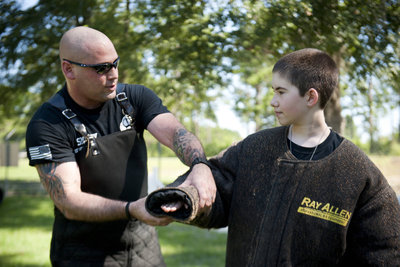
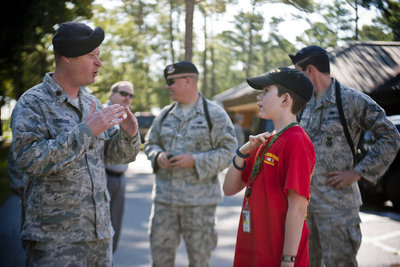
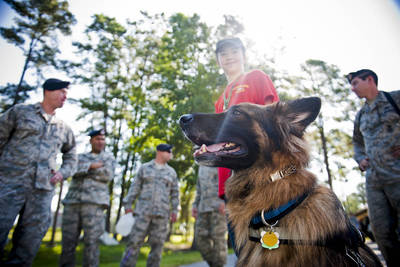


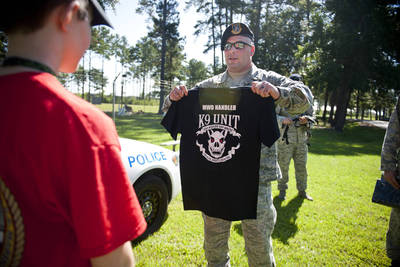
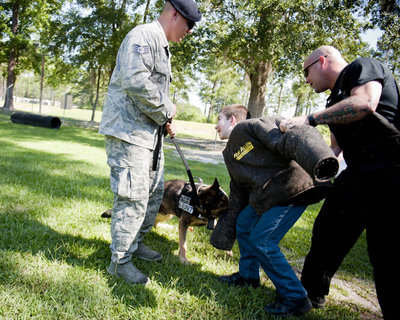
Dog handler for a day: a dream comes true
7/12/2012 - MOODY AIR FORCE BASE, Ga. -- Courage is a quality often associated with fighters, and fighting is something 13-year-old Christopher Carswell has been doing since he was born.
Christopher, an epilepsy patient, has dealt with and overcome many health problems over the years including partial blindness, joint issues and seizures. In 2007, his fist seizure sent him into cardiac arrest and left him in a coma for seven and a half hours.
The Brunswick, Ga., native recently visited Moody Air Force Base, Ga., where he shadowed the base's military working dog unit and was named an honorary dog handler for a day.
Read More...
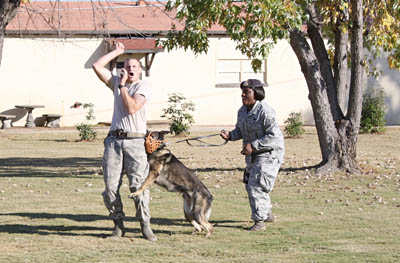
Not your average animal-- Military working dogs support security forces' missions
1/4/2013 - MAXWELL AIR FORCE BASE, Ala. -- -- Sweeping buildings on a mission to protect, their noses are their most dangerous weapon.
With a heightened sensitivity, more acute than a human's sense of smell, able to sniff out the slightest trace of explosive material or narcotics, these canines are more than man's best friend - they are warriors.
Read More...
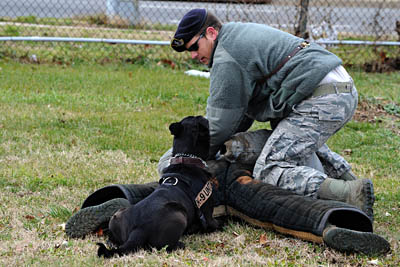

AFDW Airmen showcase skills, share knowledge before Military Bowl
1/4/2013 - WASHINGTON, D.C. -- Several Airmen assigned to the Air Force District of Washington showcased their skills and shared their stories with football fans before the 2012 Military Bowl at the Robert F. Kennedy Memorial Stadium here Dec. 27.
Read More...
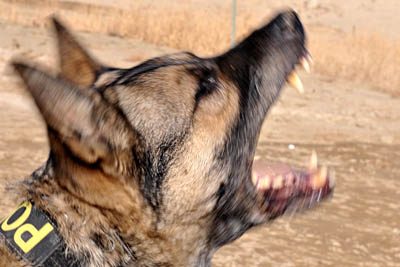
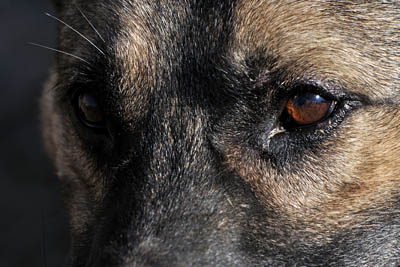

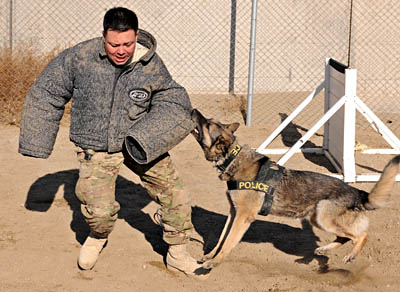
Defend the Installation: the dogs of war
1/1/2013 - BAGRAM AIRFIELD, Afghanistan -- Editor's Note: This is the first in a three-part series of articles on how the 455th Expeditionary Security Forces Group safeguards the people and equipment on Bagram Airfield.
Tucked into a small corner of this sprawling base is an important cog in its protection.
At the aptly named "Camp Kujo," the military working dogs of the 455th Expeditionary Security Forces Squadron train and prepare to go out on missions both inside and outside the wire, day and night.
Read More...


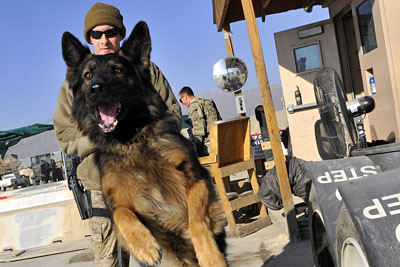
Military working dog and handler work side by side
12/5/2012 - Staff Sgt. Mark Sidle, 455th Expeditionary Security Forces Group dog handler, and his dog, Arco, stand guard at an entry control point at Bagram Airfield, Afghanistan, Dec. 1, 2012. The 455 ESFG military working dog handlers work side by side with their dogs, searching vehicles for illegal drugs and explosives. (U.S. Air Force photo/Senior Airman Chris Willis)
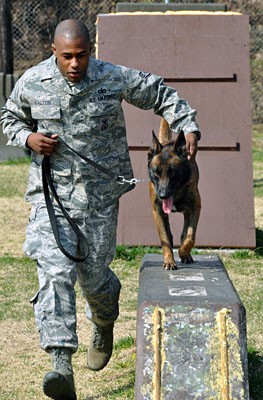
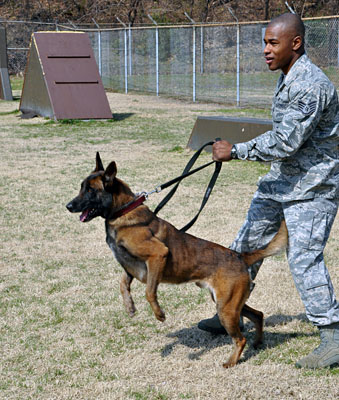
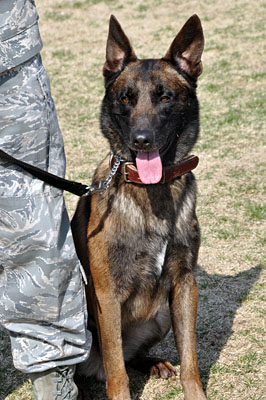


Take this job and love it: Four-legged Airmen bred to serve
4/20/2012 - OSAN AIR BASE, Republic of Korea -- Editor's Note: This is the final in a series called "Take this job and love it," which are stories based on service members with interesting careers and their experiences.
For most individuals looking at Security Forces, they envision a very professional service member in a crisply pressed uniform, but normally forget the four-legged Airmen who serve beside them.
Military working dogs are used by the Department of Defense as a resource for explosive and drug detection as well as patrol work.
Read More...
Video Link


Keep Running - Don't Look Back
8/2/2012 - SOUTHWEST ASIA -- Effective communication, training and hard work is required for a bond to form between canine and its handler. Additionally, extra time and effort helps prepare the dogs for real-world scenarios through various exercises.
The Military Working Dogs in the 386th Expeditionary Security Forces Squadron work alongside their handlers searching buildings and sniffing for drugs, explosives and crime suspects.
The primary mission for MWD is providing protection capabilities for base personnel and assets.
Read More...
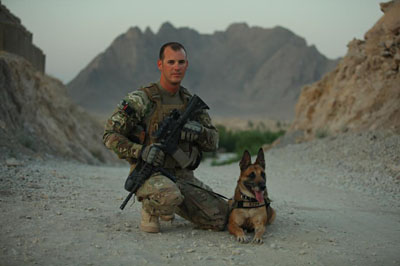

An Iceman and His Best Friend
10/17/2012 - EIELSON AIR FORCE BASE, Alaska -- Editor's note: This is part one of a series featuring Staff Sgt. Leonard Anderson and his military working dog, Azza.
"The one absolutely unselfish friend that a man can have in this selfish world, the one that never deserts him and the one that never proves ungrateful or treacherous, is his dog." -- George Graham Vest
The saying goes that dog is man's best friend. In the world of military working dogs, this bond becomes something more due to one simple fact: in a life or death situation, man relies upon dog for survival and vice versa.
Read More...

An Iceman and his best friend: An unforgettable day
10/29/2012 - EIELSON AIR FORCE BASE, Alaska -- Editor's note: This is the second part of a series featuring Staff Sgt. Leonard Anderson and his military working dog, Azza.
"The person who has nothing for which he is willing to fight, nothing which is more important than his own personal safety, is a miserable creature and has no chance of being free unless made and kept so by the exertions of better men than himself." - John Stuart Mill
He had a premonition.
The morning of his fifth mission, Staff Sgt. Leonard Anderson, 354th Security Forces Squadron military working dog handler, told his comrades that something did not feel right.
Read More...
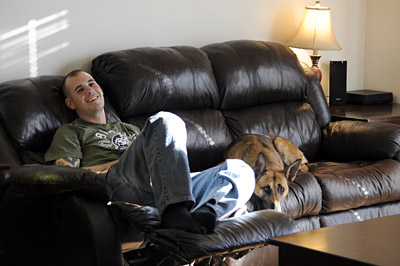
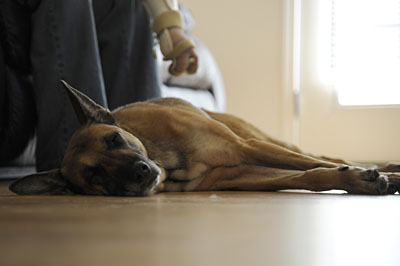

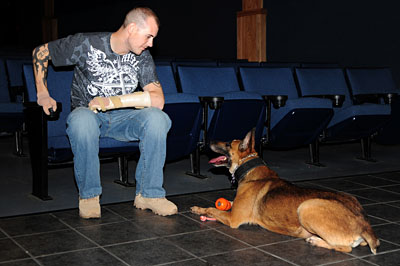


An Iceman and his best friend: A look to the future
11/15/2012 - EIELSON AIR FORCE BASE, Alaska -- Editor's note: This is the third part of a series featuring Staff Sgt. Leonard Anderson and his military working dog, Azza.
"He is your friend, your partner, your defender, your dog. You are his life, his love, his leader. He will be yours, faithful and true, to the last beat of his heart." -- Unknown
He walks with a slight limp, but he holds a certain determination in his gait.
As he sits, she rests her head beside him. She watches him when he moves, keeping a trained eye focused on his movements.
The two are old friends, partners - they are family.
Read More...
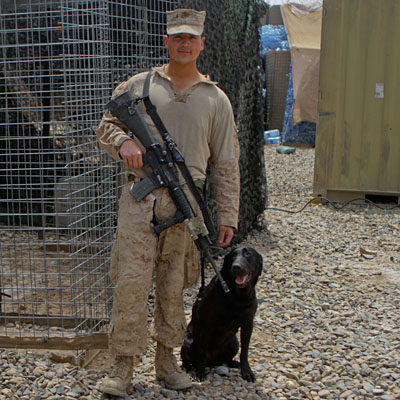
Face of Defense: Dog Handler Enjoys Responsibilities
Many children beg their parents for a dog. The floppy ears and wagging tail seem to attract children to man's best friend. But many parents know that caring for a dog means a lot of responsibility, training and effort.
Dog handlers in the Marine Corps not only shoulder that same responsibility — they volunteer for it on top of the responsibilities of being deployed to Afghanistan.
For Marine Corps Cpl. Jeffery Rodriguez, a dog handler with Weapons Company, 2nd Battalion, 6th Marine Regiment, those responsibilities are more like a privilege.
Read More...
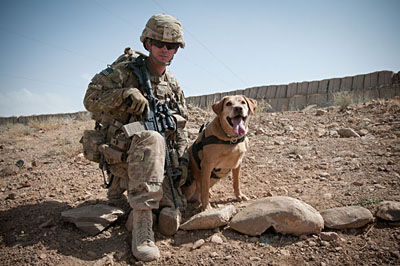
Tactical Explosive Detector Dogs keeping Soldiers, Afghan civilians safer
Soldiers on today's modern battlefield have tools that we all know well. We often think of rifles, hand grenades and up-armored vehicles — but what about dogs? Soldiers deployed to Afghanistan with the 4th Infantry Brigade Combat Team, 1st Infantry Division, known as the "Dragons," are changing the game when it comes to finding roadside bombs in their area of operations.
Pfc. John Casey, an infantryman and native of Orting, Wash., is a member of a Tactical Explosive Detector Dog team, or TEDD, supporting operations in Paktika and Ghazni provinces.
Read More...
